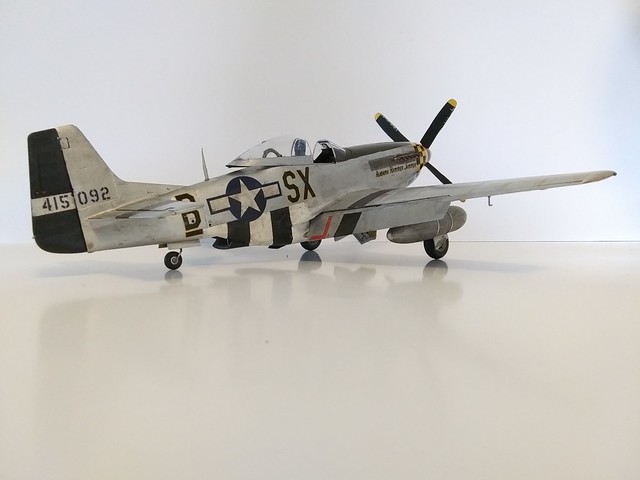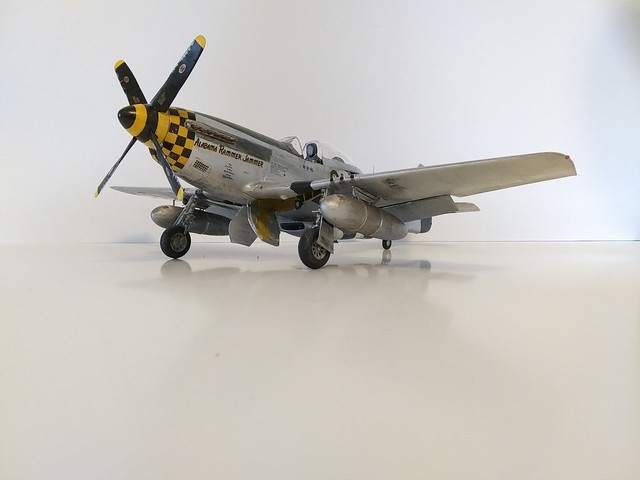John> As to the aerial wire, it became a moot point. I learned that most P-51Ds of the 8th Air Force didn't have aerial wires. Learn something new everyday!
Well, it's finally finished, or finished as in “I don't want to work on this anymore”. This 1/32nd scale P-51 has led me on some interesting adventures in modeling. Can't say I enjoyed them.
First some history. Arthur C. Cundy Jr. was born in Birmingham, Alabama on the Fourth of July, 1924. His father was a veteran of the 1st World War. His mother, Virginia Key, served as a recruiting officer in the WACs. She was a direct descendant of Francis Scott Key, who wrote "The Star-Spangled Banner".
Cundy joined the USAAF in 1943, and graduated from flight school in 1944. He arrived in England in August, assigned to the 352nd Fighter Squadron of the 353rd Fighter Group, based at Raydon in East Anglia and reported to the unit on August 21. The 353rd was the fourth fighter group assigned to the Eighth Air Force, and had become operational in August 1943, just in time to participate in the Regenseburg-Schweinfut mission. At the time Cundy arrived, the group was still flying the P-47 Thunderbolt.
The 353rd re-equipped with the P-51D beginning in October, and was fully operational on the Mustang by mid-November. Cundy scored his first victory, a Bf-109, on November 27. He shot down a Fw-190 the next month. By January 1945, he had moved up to element leader and been promoted to 1st Lieutenant.
On March 2, 1945, Cundy claimed two Fw-190s and one Bf-109 to become an ace with a total of six victories.
On March 11, Cundy was flying P-51D Mustang SX-D 44-14963 “Miss Jackie II,” the personal aircraft of 1st Lieutenant Lindsay W. Grove, when it developed a coolant leak over the North Sea as the group flew outbound toward Germany. Cundy reported he was heading back to England, and was last seen diving through the undercast. His remains have never been recovered.
I've chosen to portray his aircraft as it “might” have appeared in December / January 44/45. The paint scheme changed over the few months in service, so there's some doubt about what it actually looked like. I went by this photo and guessed on tail and wing markings, though it's a good guess.

Note I didn't detail the aircraft as others have. The build was straight out of the box.






Now about the model.
The Good:
-
It's about half the price of a Tamiya kit. If you don't want to detail an engine and open panels then by all means this is for you.
-
Detail is good on pit and surface detail . You can look at "Plasticjunkie's" P-51 NA-5 to see what can be done with it. Sufficient parts are available to make different versions (3 canopys, 2 seats, etc.)
-
Sufficient decals are there to build two versions. I didn't use all of them as I figured they would be painted over as time went on. They went on and laid down nicely, so I have no complaints about them.
- Fit is tight. I had to sand the bottom of the cockpit some to get the wings to fit. Watch out for assembling parts and one out of alignment can mess you up, but at least it cuts down on putty!
The Bad:
-
Canopies sometimes are bad. Ask "Plasticjunkie" about his troubles. Also, canopies are not wide enough to show closed, but are okay if shown in the open position. You might want to check if you have one.
-
The landing gear is weak, and metal ones are recommended. Ask me how I know!
-
The instructions are poor. It doesn't tell you about parts, and you have to do some research to determine what to use. I know more about P-51s than before, at least.
Anyway, that's about it. I want to thank Bish for running this GB (wherever he is).
Thanks for looking!
Gary